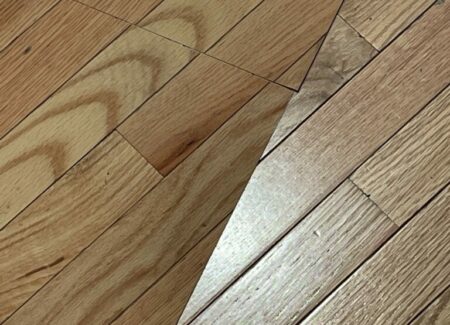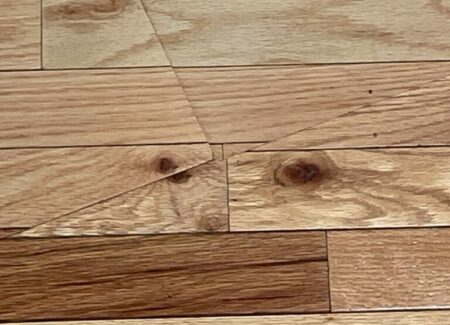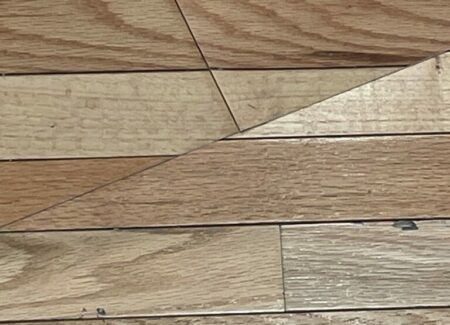JTF (just the facts): A single photographic work, installed directly on the floor of the single room gallery space. The work consists of a set of instructions typed on an index card, made originally in 1967-1969; the work is then installed per the instructions (with 21 prints placed in a single contiguous line). Here the recent color prints are each sized 18×18 inches. The work was made in an edition of 1+1AP; this is the AP. (Installation and detail shots below.)
A monograph on this work by David Campany was published in 2022 by MACK (here). Paperback with flap, 12.5 x 19.5 cm, 112 pages. (Cover shot below.)
Comments/Context: At first glance, the sweep of the gallery space at Cristin Tierney looks entirely empty – white walls, polished pine floors, windows facing the street with light streaming in, and seemingly nothing else to see. Only after walking in a few steps and looking more closely at the floor does it become apparent that there has been a subtle intervention in the space – part of the floor isn’t glossy, but matte, as though a power sander had been dragged across the floor to remove the polish. An even closer look at this area then reveals an even more improbable discovery – the honey-colored floor hasn’t been sanded or prepped for refinishing, but a series of exacting photographs of that stretch of floor has been laid down in a long rectangle, with the scale, color, and alignment of the images so near to perfect that the illusion feels plausibly “real”. It’s the kind of conceptual work that at first seems strangely odd, and then after looking at it a while longer, starts to feel all the more astonishingly brilliant.
“Photopath” was conceived by the British artist Victor Burgin in 1967, soon after he graduated from Yale, and the work was first installed in a friend’s apartment in Nottingham, England, later that year. The late 1960s and early 1970s were an innovative time in photography, particularly within a subset of artists who were exploring the conceptual (and in many cases, illusionistic) possibilities of the medium and its inherently self-reflexive image/object duality.
Burgin was actually coming at some of these same ideas from a different angle, trying to rethink sculpture in non-material ways. “Photopath” isn’t a sculpture in the usual sense – it’s an idea printed on an index card, which is then later given physical form as specific photographs installed in a particular place. Like Sol Le Witt’s wall drawings (which he began in 1969), the work only exists as words/instructions, until such time as it is re-installed. And like Carl Andre’s flat floor sculptures from the mid to late 1960s, which offered an alternate plane of spatial dynamics than we were used to, “Photopath” can also be thought of as a sculpture that essentially disappears, although it does have a very thin (and temporary) physical presence.
In the years since it was first made, “Photopath” has been recreated only a handful of times, at the ICA in London in 1969, in the rotunda of the Guggenheim in 1971, and most recently, on the concrete floor in the newly renovated Art Institute of Chicago in 2011. For this new gallery installation, Burgin had to supervise the making of extremely precise photographs of the wood floor, and a few steps around the space make clear just how hard this must have been – the light shifts across the wood planks as the day progresses, the floor is dinged up and scratched in plenty of places, and given the age of the building, the floor is certainly uneven and out of level, all of these minute details adding fractional distortions and shifts that had to be compensated for when aligning the camera and later installing the resulting prints.
Part of the magic of “Photopath” is the way that it continually oscillates from real to unreal. From afar and from certain viewing angles, the work is so well integrated into its environment that it seems impossible to separate it from the reality of the surroundings. But up close, we can see the edges, seams, and corners of the prints, as well as the tiny variations in color that create visual friction between the real floor and its facsimile. Instead of feeling like mistakes of some kind, this minute evidence of the art-making process adds to the wonder of the illusion – we know Burgin has intervened in this space, but his work is so convincing that we can suspend our disbelief for just a moment and revel in the purity of his ideas and our tangible experience of them. There is something pleasingly mind bending about finding a long curved scratch in the floor and watching it seamlessly traverse the polished planks and then the photographic prints, the surface and its representation becoming indistinguishable. The same can be said of the consistently perfect alignment of the lines of the floorboards, the constant simmer of tension between the space itself and the depiction of that space keeping us off guard.
As 21st century digital printing technologies have gotten ever more powerful, the idea of printing photographic imagery on a dizzying array of potential surfaces has become more commonplace. Burgin’s work takes us back to a point in art history when the dissonance of image and object in this kind of transformative installation was much more revolutionary, and over the succeeding decade, many more photographers and conceptual artists would begin to play with the way a camera sees and the possibilities of optical trickery and performative intervention. As seen here, Burgin’s work remains freshly provocative and supremely elegant, measuring and re-imagining space in a smartly recursive loop.
Collector’s POV: This work is only available for sale to institutional collectors. Burgin’s photographic work has rarely been available in the secondary markets in the past decade, so gallery retail remains the best option for those collectors interested in following up. A survey of Burgin’s work is scheduled for exhibition at Jeu de Paume in Paris in the fall of 2023.

























Stunning, and very fine review.
Your pictures of the piece are also excellent BTW.
Ian Wallace talking about how this piece influenced him in the sixties
https://youtu.be/orf0gcHzkZ4?t=1830